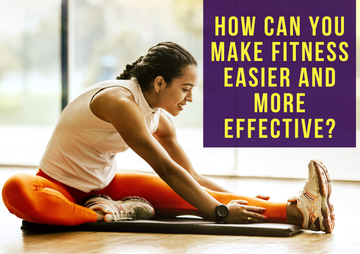3 Best Ways You Can Use the Agility Ladder To Meet Conditioning Goals
Agility training is a must for any sport, because it also involves cultivating mental alertness, while improving on speed and power. Whether you are part of a professional conditioning program or just following a more personalized one at home, there are generally two goals in mind:
- improve your physical fitness metrics: agility, endurance, power, or strength for better performance
- prevent and avoid injuries
For many team sports like basketball, soccer, and football, it's common practice for coaches to use an agility ladder for agility training to build and enhance athletic skills.
Agility ladders are one of the easiest but most effective sports conditioning tools out there that anyone can use. This agility training equipment offers more spontaneity to help you think on your feet, as opposed to just doing repetitive stationary sets with weights or treadmills.
Coaches and trainers keep agility ladders a training staple not only because they’re inexpensive and easy to set up, but they also provide more creative ways to test footwork and coordination.
In the book, “Effective Sports Conditioning Programs”, by the IDEA Health and Fitness Association, experts attest that the agility ladder has sport-specific advantages:
It works out the whole body and enhances:
- More warm-ups that are dynamic
- Bilateral mobility performing tasks by using both legs or both arms at the same time
- Eye-foot coordination
- Your peripheral instincts - having alertness for outer areas aside from your central field of vision
- Hip mobility
- Anaerobic conditioning - performing bursts of intense effort in a short amount of time.
- Lateral or linear mobility - being agile in sideways, forward and backward directions
- Weight transfer capabilities - being able to center yourself even when you shift your weight.
You get even get the bonus of movement finetuning, mental training, and better engagement. Agility ladders are so multi-functional that they also aid in rehab. All of these add up to increased motivation for training.
The catch, of course, is to use the agility ladder right so you can reap all the benefits.
Here are agility ladder best practices for ultimate sports conditioning:
1. Making the Proper Form a Habit
You need to steer clear of common agility ladder drill mistakes so that all that training doesn’t work against you. Here are prerequisites before beginning any agility training:
- one will need to have good knees and strong feet to avoid injuries
- use the agility ladder for rehab only at the advice of a professional
- get assessed for proper form by a professional to prevent injuries
The proper form consists of having the right upper body posture (non-leaning) with a low center of gravity. Take care not to do sloppy or heavy footwork, by landing on the balls of your feet.
Since the agility ladder primarily targets your lower extremities, you have to be careful not to put unnecessary weight from your upper body, or pressure with incorrect foot placements, on your feet.
If you want to train for speed, the answer is to develop stronger legs. The right form goes with leg training. Both of these combined will make for more powerful agility gains.
2. Choose the Right Training Program
There’s no one-size-fits-all training program for all sports. Just because you’re lifting weights constantly and feel like you’re getting quicker feet from long ladder drills, they don't necessarily translate to better gameplay skills.
Agility training is at the heart of the conditioning process because it has three vital components that are essential to teamplay and some solitary sports.
When you do drills that hone your reactive instincts for (1) acceleration (2) deceleration (3)change of direction, you are getting the edge you need for your sport.
It’s important to choose the right training program that has an integrative approach to build, adapt and maintain the skills you need for better performance.
To build your agility quotient, common conditioning programs employ SAQ (speed, agility, and quickness) / SARQ (speed, agility, reactiveness, and quickness) or HIFT (high-intensity functional training) programs.
These types of programs are part of a structured method to finetune movements and technique. Sample agility ladder drills include repetitive movements in different directions in a speedy manner.
A second conditioning method is to do randomized drills that mimic your sport so that you do as much intuitive movement as you can in real-time. This can involve doing agility ladder drills with a random and varying stimulus.
In the end, the best training program should make you resilient in all planes of motion. A complete program provides:
- a thorough assessment
- goals
- drills for flexibility, warm-up, balance, core, reactive, SAQ, cooldown, and strength
Make sure you are doing agility drills that have corrective exercise strategies to match your skill level. Your conditioning plan should include structured and random, but progressive drills with injury prevention in mind.
3. Choose An Agility Ladder that Has a Complete Training System
Agility training is not limited to using simple ladders but using the ladder as part of an agility training “kit”.
Your agility ladder should also be adjustable and portable, with safety features for injury prevention. High-quality ladders are built for anyone to use, professional or junior athletes alike.
The best agility ladders are part of a system that includes added accessories like chutes, and cones, including a training guide with exercises. This can help you condition even in the off-season.
Check out our recommendations for the top agility ladders on the market today!
Expanding Your Agility Ladder Drill Benefits In Season and Off
True agility training is going beyond perfectly executed drills - knowing how to structure them, while using the right intensity, and applying a recovery cycle can boost your performance.
Keep in mind that the proper form is critical (having a low center of gravity), along with maintaining your center in acceleration, deceleration, and change of direction, in whatever method of conditioning (structured or random) will take time to perfect.
Use your agility ladder to build new skills in the off-season, finetune them close to pre-season training and maintain them in-season, so that you’ll always be in top form.



















